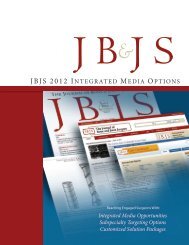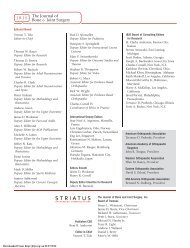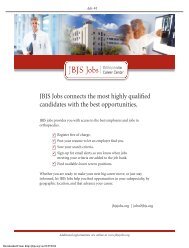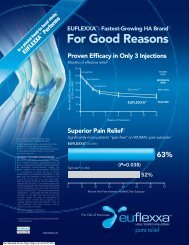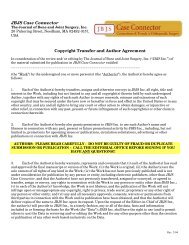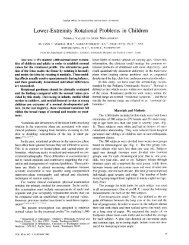Review Questions - The Journal of Bone & Joint Surgery
Review Questions - The Journal of Bone & Joint Surgery
Review Questions - The Journal of Bone & Joint Surgery
Create successful ePaper yourself
Turn your PDF publications into a flip-book with our unique Google optimized e-Paper software.
cme 1<br />
THE JOURNAL OF BONE & JOINT SURGERY · JBJS. ORG VOLUME 89-A · CME III · JUL, AUG, SEP 2007<br />
<strong>The</strong> <strong>Journal</strong> <strong>of</strong> <strong>Bone</strong> & <strong>Joint</strong> <strong>Surgery</strong><br />
Continuing Medical Education<br />
CME<br />
<strong>Review</strong> <strong>Questions</strong><br />
July, August, September<br />
2007<br />
This CME exam is also available at jbjs.org as an interactive online exam.<br />
Credits earned by completing and submitting this exam online can be<br />
applied to the Scored and Recorded self-assessment requirement as<br />
mandated by the ABOS Maintenance <strong>of</strong> Certification (MOC) Process.<br />
<strong>The</strong> deadline to submit your answers for grading this set <strong>of</strong> questions is January 15, 2008.<br />
COPYRIGHT © 2007 BY THE JOURNAL OF BONE AND JOINT SURGERY, INCORPORATED
cme 2<br />
THE JOURNAL OF BONE & JOINT SURGERY · JBJS. ORG VOLUME 89-A · CME III · JUL, AUG, SEP 2007<br />
PURPOSE<br />
<strong>The</strong> purposes <strong>of</strong> this CME program are:<br />
• To provide the general orthopaedic surgeon with<br />
an ability to assess his or her continuing competence<br />
in orthopaedics through the acquisition <strong>of</strong><br />
contemporary scientific information.<br />
• To provide a broad-based review and update <strong>of</strong> the<br />
major subspecialty areas in orthopaedics.<br />
• To make <strong>The</strong> <strong>Journal</strong> reader aware <strong>of</strong> new advances<br />
in orthopaedic surgical techniques and technology.<br />
INSTRUCTIONS<br />
In order to benefit most from this educational experience<br />
and qualify for Continuing Medical Education<br />
credit, please observe the following instructions:<br />
1. Read the learning objectives listed on the Response<br />
Form and be certain that they meet your<br />
individual learning needs.<br />
2. <strong>The</strong>se CME questions have been derived from the<br />
information presented in the July, August, and September<br />
issues <strong>of</strong> the 2007 American volume <strong>of</strong><br />
<strong>The</strong> <strong>Journal</strong> <strong>of</strong> <strong>Bone</strong> and <strong>Joint</strong> <strong>Surgery</strong> (Vol. 89-A).<br />
A careful study <strong>of</strong> each article should yield the best<br />
response to each question.<br />
3. Record your answers and complete all portions <strong>of</strong><br />
the attached Response Form in the back <strong>of</strong> this document.<br />
Upon successful completion <strong>of</strong> the examination,<br />
you may claim up to ten category-1 CME credits.<br />
However, to claim up to ten credits to satisfy selfassessment<br />
examination requirements mandated by<br />
the Maintenance <strong>of</strong> Certification process, you must<br />
take the online JBJS quarterly examination.<br />
4. In order for the American Academy <strong>of</strong> Orthopaedic<br />
Surgeons to document your participation in the<br />
CME activity, Academy Fellows must provide their<br />
AAOS membership number in the designated area<br />
on the Response Form.<br />
5. In addition to providing the answers to the CME<br />
questions, you must complete the examination evaluation<br />
questions. <strong>The</strong>se questions are found on the<br />
Response Form. <strong>The</strong> way you answer these evaluation<br />
questions will not in any way affect the score<br />
that you achieve.<br />
6. All completed answer sheets will be graded, and you<br />
will be advised <strong>of</strong> the results <strong>of</strong> this examination<br />
within four weeks after it is received. In order to qualify<br />
for CME credit, a score <strong>of</strong> more than 50% correct<br />
must be achieved on the examination. A charge <strong>of</strong><br />
$45 per quarter, or $165 per year, must be paid<br />
at the time that the answer sheet is submitted.<br />
<strong>The</strong> deadline to submit your answers for grading<br />
this set <strong>of</strong> questions is January 15, 2008.<br />
1. Which <strong>of</strong> the following serological tests provides<br />
more diagnostic information as a screening<br />
test for the presence <strong>of</strong> infection at the site<br />
<strong>of</strong> a symptomatic total knee replacement?<br />
A. erythrocyte sedimentation rate<br />
B. C-reactive protein level<br />
C. erythrocyte sedimentation rate and C-reactive<br />
protein tests performed together as a test battery,<br />
with a positive result <strong>of</strong> either test considered<br />
to be a positive result for the test battery<br />
D. erythrocyte sedimentation rate and C-reactive<br />
protein tests performed together as a test battery,<br />
with positive results <strong>of</strong> both tests considered<br />
to be a positive result for the test battery<br />
E. erythrocyte sedimentation rate and C-reactive<br />
protein tests, with each considered as a separate<br />
test<br />
2. <strong>The</strong> most important predictor <strong>of</strong> complex<br />
regionl pain syndrome type I after a wrist<br />
fracture is:<br />
A. dominance <strong>of</strong> the side <strong>of</strong> the fracture<br />
B. female gender<br />
C. older age<br />
D. early cast-related complaints<br />
E. fracture type<br />
3. All <strong>of</strong> the following statements regarding bimalleolar<br />
ankle fractures as compared with<br />
lateral malleolar fractures with deltoid ligament<br />
injury are true, except:<br />
A. they occur more <strong>of</strong>ten in patients over sixty<br />
years <strong>of</strong> age<br />
B. they are seen more commonly in female patients<br />
C. they tend to have a poorer outcome at one year<br />
after surgery<br />
D. they occur more commonly in patients with multiple<br />
comorbidities<br />
E. they are more common in diabetics<br />
4. In one study, what was the most common<br />
postoperative complication <strong>of</strong> reverse total<br />
shoulder arthroplasty?<br />
A. infection<br />
B. glenoid fracture<br />
C. musculocutaneous nerve palsy<br />
D. dislocation<br />
E. glenoid base loosening<br />
5. A seven-year-old boy with known osteogenesis<br />
imperfecta has incurred many upper-limb fractures<br />
over several years. Pamidronate treatment<br />
was commenced two years previously,<br />
and it reduced the fracture rate dramatically.<br />
A recent knee radiograph showed multiple<br />
fine horizontal bands in the metaphyseal<br />
areas <strong>of</strong> the distal part <strong>of</strong> the femur and<br />
the proximal part <strong>of</strong> the tibia. On the basis<br />
<strong>of</strong> the treatment and the radiographic findings,<br />
it appears that:<br />
A. the action <strong>of</strong> pamidronate is to inhibit osteoclast<br />
activity<br />
B. zebra lines due to pamidronate treatment are<br />
readily distinguishable from Harris growth arrest<br />
lines
cme 3<br />
THE JOURNAL OF BONE & JOINT SURGERY · JBJS. ORG VOLUME 89-A · CME III · JUL, AUG, SEP 2007<br />
C. pamidronate treatment slows the longitudinal<br />
growth <strong>of</strong> long bones<br />
D. pamidronate treatment <strong>of</strong> children with osteogenesis<br />
imperfecta results in decreased mineralization<br />
<strong>of</strong> new bone<br />
E. zebra lines occasionally can be seen in the epiphyses<br />
<strong>of</strong> long bones<br />
6. <strong>The</strong> mechanical stability <strong>of</strong> fracture fixation<br />
influences the healing outcome. In a sheep<br />
tibial fracture model:<br />
A. an increased nail diameter improved healing by<br />
reducing interfragmentary movements<br />
B. placing the locking screws in the anteromedial<br />
plane improved healing by increasing the shear<br />
and torsional fixation stability<br />
C. using angle-stable locking screws improved healing<br />
by increasing the shear and torsional fixation<br />
stability<br />
D. reducing the number <strong>of</strong> locking screws improved<br />
healing by decreasing the axial fixation stability<br />
E. using angle-stable locking screws improved healing<br />
by increasing the axial fixation stability<br />
7. Which <strong>of</strong> the following is considered ineffective<br />
for decreasing the risk <strong>of</strong> a postoperative<br />
wound infection?<br />
A. administration <strong>of</strong> broad-spectrum antibiotics<br />
within one hour before the incision time<br />
B. continuing intravenous antibiotics for forty-eight<br />
hours after surgery<br />
C. using clippers to remove hair in the surgical area<br />
D. administration <strong>of</strong> antibiotics within three hours<br />
after an open fracture<br />
E. removing drains within twenty-four hours after<br />
surgery<br />
8. In comparison with those <strong>of</strong> cervical fusion,<br />
the early results <strong>of</strong> cervical disc arthroplasty<br />
suggest:<br />
A. a superior early outcome in the arthroplasty<br />
group<br />
B. deteriorating outcomes at six years<br />
postoperatively<br />
C. a higher complication rate in the arthroplasty<br />
group<br />
D. progression <strong>of</strong> adjacent segment disease in<br />
the absence <strong>of</strong> preexisting disease<br />
E. 5° to 10° improvement in the mean range<br />
<strong>of</strong> motion<br />
9. Functional outcomes following amputation<br />
for the treatment <strong>of</strong> limb-threatening lowerextremity<br />
injury are similar to those following<br />
reconstruction. Which <strong>of</strong> the following statements<br />
best describes the comparative lifetime<br />
costs <strong>of</strong> the two treatments?<br />
A. there are no differences<br />
B. costs for rehospitalizations due to complications<br />
related to limb reconstruction are more than the<br />
additional cost <strong>of</strong> the prosthesis<br />
C. lifetime costs for limb reconstruction are substantially<br />
less than those for limb amputation<br />
D. only above-the-knee amputations are more<br />
costly, over a lifetime, than limb reconstructions<br />
E. newer materials are making prostheses less<br />
expensive<br />
10. Following posterior atlantoaxial arthrodesis,<br />
there are limitations in cervical spine motion,<br />
particularly in axial rotation. <strong>The</strong> most likely<br />
reason for this finding is that:<br />
A. postoperative immobilization is required<br />
B. this technique is associated with a high rate <strong>of</strong><br />
technical failure<br />
C. patients are placed in a prone position during<br />
the surgery<br />
D. 50% <strong>of</strong> rotation occurs at the atlantoaxial joint<br />
E. this technique is associated with a high rate <strong>of</strong><br />
delayed union or nonunion<br />
11. In a group <strong>of</strong> patients with pyogenic flexor<br />
tenosynovitis, which factor was not significantly<br />
associated with an increased rate <strong>of</strong><br />
amputation?<br />
A. age <strong>of</strong> more than forty-three years<br />
B. presence <strong>of</strong> diabetes mellitus, peripheral vascular<br />
disease, or renal failure<br />
C. presence <strong>of</strong> subcutaneous purulence<br />
D. history <strong>of</strong> penetrating injury<br />
E. involvement <strong>of</strong> more than one bacterial type<br />
12. Which <strong>of</strong> the following factors is associated<br />
with better survival <strong>of</strong> patients with metastatic<br />
renal cell carcinoma?<br />
A. female gender<br />
B. en bloc resection<br />
C. metastases only to osseous sites<br />
D. non-clear-cell histological subtype<br />
E. metastases to multiple sites<br />
13. In a total hip replacement, the proximal design<br />
<strong>of</strong> the femoral component and the position <strong>of</strong><br />
the stem in the femoral canal will determine<br />
the:<br />
A. head size<br />
B. hip <strong>of</strong>fset and length<br />
C. cup size<br />
D. choice <strong>of</strong> articulation surface<br />
E. time <strong>of</strong> operation<br />
14. Which <strong>of</strong> the following has been identified<br />
as the most important predictor <strong>of</strong> the<br />
clinical outcome <strong>of</strong> a revision total hip<br />
arthroplasty?<br />
A. duration from the index total hip arthroplasty<br />
B. duration <strong>of</strong> waiting time prior to the revision<br />
C. type <strong>of</strong> anesthesia<br />
D. a good preoperative WOMAC functional score<br />
E. type <strong>of</strong> previous implant design and fixation<br />
method<br />
15. Which <strong>of</strong> the following factors has the strongest<br />
positive correlation with self-assessed<br />
outcome after rotator cuff repair?<br />
A. gender<br />
B. preoperative expectations<br />
C. preoperative range <strong>of</strong> motion<br />
D. preoperative strength<br />
E. tear size
cme 4<br />
THE JOURNAL OF BONE & JOINT SURGERY · JBJS. ORG VOLUME 89-A · CME III · JUL, AUG, SEP 2007<br />
16. Acute compartment syndrome in a normal limb<br />
during surgery is a known and potentially devastating<br />
complication that can lead to permanent<br />
neuromuscular damage. During spine<br />
surgery, which surgical position and patient<br />
characteristic have been shown to increase leg<br />
intramuscular pressure in the dependent anterior<br />
compartment?<br />
A. prone with chest rolls and elevated patient<br />
weight<br />
B. kneeling with the hips and knees flexed 90° (on<br />
an Andrews Spinal <strong>Surgery</strong> Table) and elevated<br />
patient weight<br />
C. kneeling with the hips and knees flexed 90°<br />
(on an Andrew Spinal <strong>Surgery</strong> Table) and a taller<br />
patient<br />
D. suspended legs with the hips and knees flexed<br />
45° (on a Jackson Spinal Table Top) and a taller<br />
patient<br />
E. suspended legs with the hips and knees flexed<br />
45° (on a Jackson Spinal Table Top) and elevated<br />
patient body mass index<br />
17. <strong>The</strong> most common alteration in gait following<br />
arthrodesis <strong>of</strong> the first metatarsophalangeal<br />
joint is:<br />
A. increased weight-bearing at the second metatarsal<br />
head during the loading response<br />
B. hypermobility <strong>of</strong> the first ray on heel strike<br />
C. decreased step length<br />
D. increased flexion <strong>of</strong> the first interphalangeal<br />
joint on stance<br />
E. increased ankle plantar flexion<br />
18. A patient sustains an acute knee dislocation<br />
with a tear <strong>of</strong> the superficial medial collateral<br />
ligament <strong>of</strong>f the femur. A primary repair <strong>of</strong> the<br />
superficial medial collateral ligament would result<br />
in reattachment closest to what femoral<br />
osseous landmark?<br />
A. the gastrocnemius tubercle<br />
B. the adductor tubercle<br />
C. the medial epicondyle<br />
D. the lateral intermuscular septum<br />
E. the trochlear groove<br />
19. Which <strong>of</strong> the following was found in the articular<br />
cartilage chondrocytes from animals<br />
systemically infected with a retrovirus?<br />
A. infectious retrovirus<br />
B. p27 antigen<br />
C. proviral DNA<br />
D. viral reverse transcriptase<br />
E. none <strong>of</strong> the above<br />
20. Complex or irreducible metacarpophalangeal<br />
joint dislocations are due to entrapment <strong>of</strong> the:<br />
A. flexor tendon<br />
B. extensor tendon<br />
C. central slip<br />
D. volar plate<br />
E. lumbrical<br />
21. Which <strong>of</strong> the molecules listed below has been<br />
shown in animal studies to increase bone mass<br />
and improve fracture healing?<br />
A. TGF-β<br />
B. PDGF<br />
C. scleraxis<br />
D. IL-10<br />
E. PTH<br />
22. In one study, the risk <strong>of</strong> complex regional pain<br />
syndrome type I after a wrist fracture was reduced<br />
with:<br />
A. estrogen replacement therapy<br />
B. 50 mg <strong>of</strong> vitamin C daily<br />
C. multivitamins daily<br />
D. bisphosphonate therapy<br />
E. 500 mg <strong>of</strong> vitamin C daily<br />
23. Perioperative mortality is one <strong>of</strong> the potential<br />
complications <strong>of</strong> total elbow arthroplasty.<br />
Which <strong>of</strong> the following factors has been shown<br />
to increase the risk <strong>of</strong> this complication?<br />
A. age at the time <strong>of</strong> surgery<br />
B. gender<br />
C. revision total elbow arthroplasty<br />
D. preoperative diagnosis <strong>of</strong> distal humeral fracture<br />
or nonunion<br />
E. rheumatoid arthritis<br />
24. In one study, use <strong>of</strong> allogenic onlay cortical<br />
graft combined with recombinant human<br />
osteogenic protein-1 (rhOP-1) was found<br />
to enhance fixation <strong>of</strong> segmental bonereplacement<br />
prostheses through extracortical<br />
bone-bridging and ingrowth. All <strong>of</strong> the<br />
following are considered to be effects <strong>of</strong><br />
rhOP-1, except:<br />
A. an increase in periosteal mineralized area<br />
B. an increase in bone ingrowth<br />
C. new bone formation at the prosthesis-host bone<br />
junction<br />
D. prevention <strong>of</strong> allograft resorption<br />
E. allograft integration with the extracortical bone<br />
envelope<br />
25. <strong>The</strong>re have been several overlapping systematic<br />
reviews <strong>of</strong> anterior cruciate ligament<br />
reconstructions comparing bone-patellar<br />
tendon-bone autografts to hamstring tendon<br />
autografts. According to the best available<br />
evidence derived from a methodologically<br />
sound meta-analysis, which <strong>of</strong> the following<br />
is most accurate?<br />
A. hamstring tendon autografts are superior for preventing<br />
anterior knee pain, and there is little evidence<br />
that bone-patellar tendon-bone autografts<br />
provide better stability<br />
B. bone-patellar tendon-bone autografts are superior<br />
for preventing anterior knee pain, and there<br />
is little evidence that hamstring tendon autografts<br />
provide better stability<br />
C. hamstring tendon autografts are superior for<br />
preventing anterior knee pain and provide better<br />
stability<br />
D. bone-patellar tendon-bone autografts are superior<br />
for preventing anterior knee pain and provide<br />
better stability
cme 5<br />
THE JOURNAL OF BONE & JOINT SURGERY · JBJS. ORG VOLUME 89-A · CME III · JUL, AUG, SEP 2007<br />
E. there is too little evidence to suggest whether<br />
bone-patellar tendon-bone autografts or hamstring<br />
tendon autografts are superior for preventing<br />
anterior knee pain or provide better stability<br />
26. Which statement about povidone-iodine is<br />
true?<br />
A. its efficacy is equal to that <strong>of</strong> chlorhexidine<br />
gluconate on skin contact<br />
B. it can be inactivated by blood and serum<br />
proteins<br />
C. it is maximally effective before it is allowed<br />
to dry<br />
D. its antimicrobial activity is longer lasting than<br />
that <strong>of</strong> chlorhexidine gluconate<br />
E. it is more effective than ChloraPrep (chlorhexidine<br />
gluconate and isopropyl alcohol) for<br />
decreasing bacterial counts in foot and ankle<br />
surgery<br />
27. A pin-care protocol developed for use with<br />
external fixation devices includes all <strong>of</strong> the<br />
following, except:<br />
A. avoidance <strong>of</strong> thermal damage to bone by preventing<br />
transcortical pin placement<br />
B. placement <strong>of</strong> each compartment on stretch<br />
during pin passage<br />
C. stabilizing skin with mild compression to prevent<br />
pistoning <strong>of</strong> s<strong>of</strong>t tissue<br />
D. frequent and early pin care in the hospital and<br />
adjunctive chemical cleaning in the outpatient<br />
setting<br />
E. use <strong>of</strong> safe anatomic windows<br />
28. Which <strong>of</strong> the following factors is most<br />
predictive <strong>of</strong> the risk <strong>of</strong> recurrent shoulder<br />
dislocation?<br />
A. age<br />
B. sex<br />
C. sports hours per year<br />
D. participation in contact/collision sports<br />
E. occupational use <strong>of</strong> the arm<br />
29. In counseling an eighteen-year-old male highschool<br />
athlete after his first shoulder dislocation,<br />
which <strong>of</strong> the following statements would<br />
be least true?<br />
A. the risk <strong>of</strong> a second dislocation is >50% in your<br />
age group<br />
B. only 50% <strong>of</strong> patients with an unstable shoulder<br />
in your age group voluntarily choose surgery<br />
C. if your shoulder remains stable, your level <strong>of</strong> satisfaction<br />
is likely to be very high<br />
D. your shoulder will not do well without surgery<br />
E. if you do not go back to contact or collision<br />
sports or use your arm above your head in your<br />
job, the chances <strong>of</strong> future instability are low<br />
30. <strong>The</strong> biggest disadvantage <strong>of</strong> ultrasonography<br />
for imaging <strong>of</strong> the shoulder <strong>of</strong> an infant is:<br />
A. the need for sedation and an NPO (nothing<br />
by mouth) status<br />
B. difficulty in interpreting images<br />
C. lack <strong>of</strong> interobserver reliability<br />
D. lack <strong>of</strong> definition <strong>of</strong> anterior joint detail<br />
E. comparative lack <strong>of</strong> definition in younger<br />
patients<br />
31. At what time-interval following injury does<br />
irrigation <strong>of</strong> a contaminated wound result in<br />
the greatest ability to remove bacteria?<br />
A. three hours<br />
B. six hours<br />
C. nine hours<br />
D. twelve hours<br />
E. twenty-four hours<br />
32. What is the most likely source <strong>of</strong> patell<strong>of</strong>emoral<br />
malalignment in patients with patella alta?<br />
A. vastus medialis weakness<br />
B. reduced femoral trochlear stability<br />
C. articular cartilage wear<br />
D. tibial torsion<br />
E. medial patell<strong>of</strong>emoral ligament tear<br />
33. Regarding the retear rate and structural<br />
changes in the rotator cuff after arthroscopic<br />
repair <strong>of</strong> a supraspinatus tear, which <strong>of</strong> the<br />
following statements is correct?<br />
A. structural changes in the rotator cuff can be<br />
reversed by a successful repair<br />
B. an intact repair leads to superior scores for pain<br />
and activities <strong>of</strong> daily living<br />
C. age is not a factor influencing the clinical outcome<br />
and structural integrity<br />
D. a high degree <strong>of</strong> preoperative fatty infiltration<br />
and atrophy <strong>of</strong> the supraspinatus are predictors<br />
<strong>of</strong> a retear<br />
E. fatty infiltration <strong>of</strong> the infraspinatus does not<br />
change postoperatively regardless <strong>of</strong> the repair<br />
integrity<br />
34. Which <strong>of</strong> the following radiographic findings<br />
correlated best with anterior knee pain after<br />
total knee arthroplasty with a resurfaced<br />
patella?<br />
A. lateral tilt<br />
B. lateral subluxation<br />
C. patellar height<br />
D. major asymmetric patellar resection (≥4 mm)<br />
E. patellar bone-femoral trochlea contact without<br />
tilt<br />
35. When a cementless stem is implanted in a<br />
total hip replacement, the combined anteversion<br />
technique requires that:<br />
A. the cup be positioned in a safe zone <strong>of</strong> 15 ± 10°<br />
<strong>of</strong> anteversion<br />
B. cup anteversion be determined after implantation<br />
<strong>of</strong> a trial femoral stem<br />
C. a femoral head <strong>of</strong> ≥32 mm be used<br />
D. the longest femoral neck size be chosen to<br />
avoid impingement<br />
E. cross-linked polyethylene be used<br />
36. A fifty-five-year-old construction worker complains<br />
<strong>of</strong> pain in the dominant shoulder. A<br />
magnetic resonance arthrogram <strong>of</strong> that shoulder<br />
demonstrates medial subluxation <strong>of</strong> the<br />
biceps tendon from the bicipital groove. During
cme 6<br />
THE JOURNAL OF BONE & JOINT SURGERY · JBJS. ORG VOLUME 89-A · CME III · JUL, AUG, SEP 2007<br />
arthroscopy <strong>of</strong> the shoulder, what other pathological<br />
finding is most likely to be observed?<br />
A. complete disruption <strong>of</strong> the transverse humeral<br />
ligament<br />
B. anterior acromial spurring<br />
C. an absent coracohumeral ligament<br />
D. pathological involvement <strong>of</strong> the rotator cuff<br />
E. hourglass deformity <strong>of</strong> the biceps tendon<br />
37. <strong>The</strong>re are hundreds <strong>of</strong> reports in the literature<br />
about the results <strong>of</strong> total ankle arthroplasty<br />
and ankle fusion. A systematic review <strong>of</strong> the<br />
available literature showed that<br />
A. the studies are well designed with clear objectives<br />
and well-stated hypotheses<br />
B. the same outcome-evaluation tools and similar,<br />
recognized follow-up protocols were used in<br />
most <strong>of</strong> the studies<br />
C. there are currently no published prospective randomized<br />
studies comparing ankle replacements<br />
with ankle fusions<br />
D. most <strong>of</strong> the studies are comparable with regard<br />
to design, patient demographics, duration <strong>of</strong><br />
follow-up, and number <strong>of</strong> patients enrolled<br />
E. ankle fusion studies had much better designs<br />
than ankle replacement studies<br />
38. After nonoperative management <strong>of</strong> massive<br />
rotator cuff tears, all <strong>of</strong> the following changes<br />
were observed except:<br />
A. a decrease in the acromiohumeral distance<br />
B. an increase in fatty infiltration <strong>of</strong> the rotator cuff<br />
muscles<br />
C. a decrease in active shoulder abduction<br />
D. progression <strong>of</strong> glenohumeral osteoarthritis<br />
E. an increase in tear size<br />
39. Inferior outcomes after lateral unicompartmental<br />
knee replacement can be expected in which<br />
situation?<br />
A. use <strong>of</strong> a medial approach<br />
B. lateral placement <strong>of</strong> the femoral component<br />
C. removal <strong>of</strong> distal femoral cartilage prior to femoral<br />
resection<br />
D. a diagnosis <strong>of</strong> posttraumatic arthritis secondary<br />
to a tibial plateau fracture<br />
E. maximizing component congruency during placement<br />
<strong>of</strong> the prosthesis<br />
40. Osteonecrosis <strong>of</strong> the femoral head can be a<br />
complication following surgical dislocation <strong>of</strong><br />
the hip. Which <strong>of</strong> the following factors is the<br />
most important to avoid this complication?<br />
A. the patient in a supine position during the<br />
operation<br />
B. use <strong>of</strong> a posterior approach<br />
C. use <strong>of</strong> a trochanteric flip osteotomy<br />
D. maintenance <strong>of</strong> the posterior capsule<br />
E. extensive s<strong>of</strong>t-tissue release<br />
41. Which <strong>of</strong> the following is the predominant site<br />
<strong>of</strong> vascular entry into the first metatarsal<br />
head?<br />
A. dorsal-medial corner<br />
B. dorsal surface<br />
C. dorsal-lateral corner<br />
D. plantar-lateral corner<br />
E. plantar-medial corner<br />
42. When you suspect that a person has an infection<br />
that might be related to an allograft, which<br />
<strong>of</strong> the following groups should be notified?<br />
A. Centers for Disease Control and Prevention (CDC)<br />
B. Food and Drug Administration (FDA)<br />
C. state or local health department<br />
D. the tissue bank<br />
E. all <strong>of</strong> the above<br />
43. A sixty-year-old man sustained a distal radial<br />
fracture. Which treatment modality yields superior<br />
patient-rated outcomes as statistically<br />
proven by Level-I evidence?<br />
A. open reduction and internal fixation with a<br />
locked plate<br />
B. open reduction and internal fixation with fragment-specific<br />
fixation<br />
C. augmented bridging external fixation<br />
D. nonbridging external fixation<br />
E. no method has been proven to be superior<br />
44. <strong>The</strong> differentiation <strong>of</strong> monocytes into osteoblasts<br />
is mediated by a molecule that also has<br />
been identified as a potential target to treat,<br />
prevent, and monitor osteolysis following total<br />
joint replacement. <strong>The</strong> molecule is:<br />
A. OP-1<br />
B. BMP<br />
C. RANK/RANKL<br />
D. Frizzled<br />
E. Smad 8<br />
45. Which characteristic <strong>of</strong> scoliosis in patients<br />
with Charcot-Marie-Tooth disease is similar to<br />
a characteristic <strong>of</strong> idiopathic scoliosis?<br />
A. majority female population<br />
B. left thoracic curve direction<br />
C. sagittal plane kyphosis<br />
D. age <strong>of</strong> onset<br />
E. response to orthotic management<br />
46. Which <strong>of</strong> the following imaging modalities<br />
is viewed as the current gold standard for<br />
delineating proximal artery abnormalities<br />
when evaluating thoracic outlet syndrome?<br />
A. two-dimensional magnetic resonance angiography<br />
B. three-dimensional magnetic resonance angiography<br />
C. magnetic resonance imaging with contrast<br />
D. arteriography<br />
E. arterial duplex examination<br />
47. After adjustment for patient characteristics<br />
and hospital procedural volume, the rate <strong>of</strong><br />
adverse outcomes following total hip and total<br />
knee replacements in specialty hospitals, compared<br />
with that in general hospitals, was:<br />
A. the same<br />
B. 20% higher<br />
C. 20% lower<br />
D. 40% higher<br />
E. 40% lower
cme 7<br />
THE JOURNAL OF BONE & JOINT SURGERY · JBJS. ORG VOLUME 89-A · CME III · JUL, AUG, SEP 2007<br />
48. On a sonogram, a normal shoulder <strong>of</strong> an infant<br />
should have an SGH or α-angle <strong>of</strong> less than or<br />
equal to:<br />
A. 30°<br />
B. 45°<br />
C. 60°<br />
D. 75°<br />
E. 90°<br />
49. Which <strong>of</strong> the following is regarded as a<br />
relevant factor in determining the risk <strong>of</strong><br />
early postoperative mortality following surgical<br />
treatment <strong>of</strong> dens fractures in elderly<br />
patients?<br />
A. surgical approach<br />
B. fracture type<br />
C. concomitant illness<br />
D. delay in treatment<br />
E. postoperative immobilization<br />
50. Patients who elect to undergo elective removal<br />
<strong>of</strong> fracture fixation hardware should expect:<br />
A. a high prevalence <strong>of</strong> indolent infection at the<br />
time <strong>of</strong> surgery<br />
B. a >75% reduction in pain at the surgery site by<br />
one year postoperatively<br />
C. 30% higher SMFA scores initially after the explantation<br />
and then at one year postoperatively<br />
D. resolution <strong>of</strong> depression as measured with the<br />
SF-36 score<br />
E. 50% more improvement if the implant is located<br />
in the upper extremity rather than the lower<br />
extremity<br />
Conflict <strong>of</strong> Interest<br />
<strong>The</strong> author <strong>of</strong> these CME questions does not have<br />
any financial conflict <strong>of</strong> interest with regard to the<br />
subject matter discussed in these review questions.
cme 8<br />
THE JOURNAL OF BONE & JOINT SURGERY · JBJS. ORG VOLUME 89-A · CME III · JUL, AUG, SEP 2007<br />
EXAMINATION EVALUATION<br />
Did the September 2007 CME <strong>Review</strong> <strong>Questions</strong> meet<br />
these educational objectives*:<br />
1. Provide a broad-based review and update specifically<br />
in the areas <strong>of</strong> orthopaedic research and<br />
spine and hip surgery?<br />
Yes No<br />
2. Strengthen your problem-solving abilities related<br />
to patient care particularly in the areas <strong>of</strong> spine<br />
and hip surgery?<br />
Yes No<br />
3. Make you aware <strong>of</strong> new advances in orthopaedic surgical<br />
techniques and technology? Yes No<br />
Comments (please comment on the quality <strong>of</strong> the questions<br />
and their relationship to your practice): ____________<br />
_______________________________________________________<br />
_______________________________________________________<br />
*Note: <strong>The</strong>se objectives will change every quarter.<br />
SURVEY (optional)<br />
1. Which <strong>of</strong> the following best describes your practice type?<br />
General orthopaedics<br />
General orthopaedics with subspecialty interest<br />
Exclusively subspecialty<br />
Resident or student<br />
Researcher<br />
Other: __________________________________________<br />
2. What are your specialty interests? Please rank in<br />
order <strong>of</strong> importance (1 = highest importance).<br />
____ Adult<br />
____ Spine<br />
____ Geriatric ____ Hand<br />
____ Pediatric ____ Rheumatology<br />
____ Rehabilitation ____ Foot and Ankle<br />
____ Sports<br />
____ Other: ________________<br />
____ Trauma<br />
3. Which is your number-one priority to read when you<br />
receive <strong>The</strong> <strong>Journal</strong> (American volume only) each<br />
month?<br />
Commercial advertising Current Concepts<br />
Classified advertising Letters to <strong>The</strong> Editor<br />
Clinical scientific articles Basic scientific articles<br />
Orthopaedic Forum Instructional Course<br />
Lectures<br />
ACCREDITATION STATEMENT<br />
This activity has been planned and implemented in accordance<br />
with the Essential Areas and policies <strong>of</strong> the<br />
Accreditation Council for Continuing Medical Education<br />
(ACCME) through the joint sponsorship <strong>of</strong> the American<br />
Academy <strong>of</strong> Orthopaedic Surgeons (AAOS) and <strong>The</strong> <strong>Journal</strong><br />
<strong>of</strong> <strong>Bone</strong> and <strong>Joint</strong> <strong>Surgery</strong> (JBJS). <strong>The</strong> AAOS is accredited<br />
by the ACCME to provide continuing medical<br />
education for physicians. <strong>The</strong> AAOS designates this educational<br />
activity for up to 10 hours <strong>of</strong> category-1 credit<br />
toward the AMA Physicians’ Recognition Award. Each<br />
physician should claim only those hours <strong>of</strong> credit that<br />
he/she actually spent in the educational activity.<br />
<strong>The</strong> deadline to submit your answers for grading this set<br />
<strong>of</strong> questions is January 15, 2008.<br />
QUESTIONS?<br />
For payment questions, contact the Subscription Department<br />
at 781-449-9780, x1240. For questions regarding<br />
submitted tests, contact Melissa Viola at 781-449-9780,<br />
x1224. E-mail all other questions to cme@jbjs.org.<br />
RESPONSE FORM<br />
ANSWER KEY<br />
Black out the correct answers<br />
1. 18. 35. <br />
2. 19. 36. <br />
3. 20. 37. <br />
4. 21. 38. <br />
5. 22. 39. <br />
6. 23. 40. <br />
7. 24. 41. <br />
8. 25. 42. <br />
9. 26. 43. <br />
10. 27. 44. <br />
11. 28. 45. <br />
12. 29. 46. <br />
13. 30. 47. <br />
14. 31. 48. <br />
15. 32. 49. <br />
16. 33. 50. <br />
17. 34. CME Credits<br />
Claimed* _________<br />
*Required. Please enter the number <strong>of</strong> CME credit hours you are claiming<br />
for this exam. You must complete this field to receive CME credit.<br />
AAOS Member Number _______________________________________<br />
(Without this number, the AAOS will not track your CME credits.)<br />
Last Name First Name Degree<br />
Mailing Address<br />
State<br />
Phone Number<br />
Zip Code<br />
Fax Number E-mail Address (optional)<br />
PAYMENT OPTIONS<br />
Payment must accompany the CME Response Form.<br />
Mail to: CME Division, <strong>The</strong> <strong>Journal</strong> <strong>of</strong> <strong>Bone</strong> and <strong>Joint</strong><br />
<strong>Surgery</strong>, 20 Pickering Street, Needham, MA 02492<br />
Subscription (4 quarterly exams)...................$165.00<br />
Single exam ..................................................$45.00<br />
Please check one:<br />
Check/money order made payable to <strong>The</strong> <strong>Journal</strong> <strong>of</strong><br />
<strong>Bone</strong> and <strong>Joint</strong> <strong>Surgery</strong> (drawn on a U.S. bank or U.S.<br />
bank draft only)<br />
Mastercard Visa AMEX<br />
Account number: ______________________________________<br />
Expiration date: ______ /_______<br />
Name as it appears on card: ___________________________<br />
I authorize my credit card to be charged $ ___________ for<br />
this activity.<br />
Signature _____________________________________________



